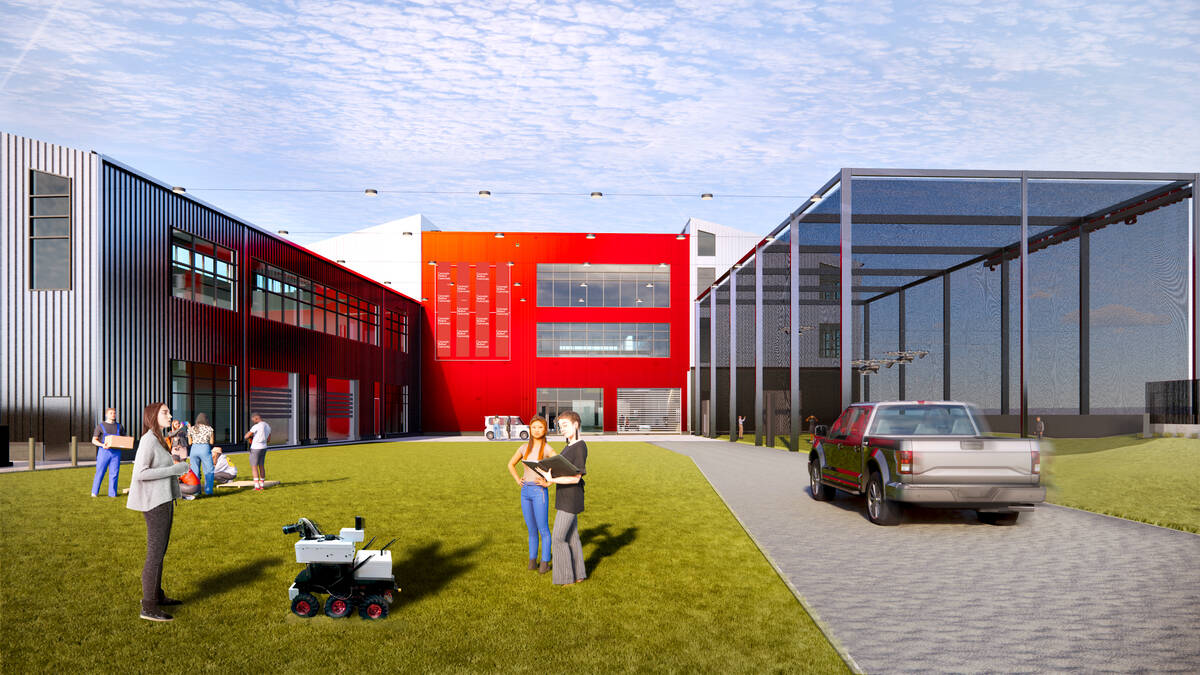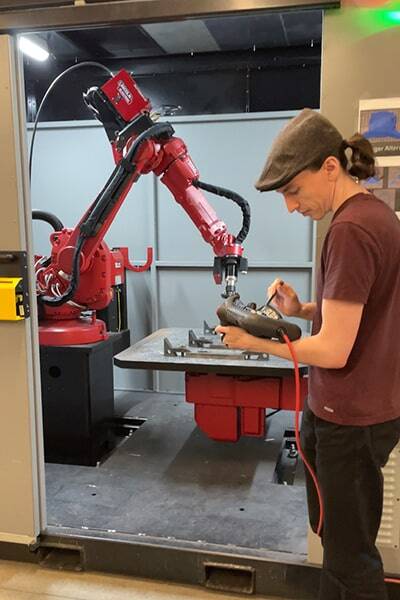Carnegie Mellon University: Launch of New Robotics Innovation Center to Anchor Community Outreach Initiatives in Hazelwood
Situated on the 178-acre site of a former steel mill, Hazelwood Green will soon include Carnegie Mellon University’s Robotics Innovation Center(opens in new window) (RIC). Upon its completion in 2025, the RIC will serve as a home to well-established programs connecting CMU and the Hazelwood community.
Future tenants, such as the Girls of Steel(opens in new window) K-12 robotics team, are eager for the opening of the cutting-edge facility.
“We’ve always just sort of scavenged for whatever space we could get,” said George Kantor(opens in new window), director of Girls of Steel and research professor in the Robotics Institute(opens in new window). “Part of having our new space at the RIC was to support the kinds of outreach that we really want to do.”
The program reaches about 300 students per year, including high school, middle school and elementary school teams that teach how to build and compete in challenges with robots. Kantor said having a permanent dedicated space in proximity to other research and innovation at the RIC may allow it to reach even more young people.
“We want this to not only be a building for CMU robotics and mechanical engineering people; we want it to be a building for the community,” he said.
As breakthroughs in the field continue at a rapid pace, researchers at Carnegie Mellon seek new ways that robotics can benefit everyday life. Expanding into Hazelwood provided the right location to engage with Pittsburgh.
The architectural features of the planned 150,000-square-foot RIC include an outdoor robot “running room” for testing and sightlines through glass windows into different labs that will help connect the public outside to the researchers inside.
“Robotics is a physical discipline. We build things that move around in the world, and we need space to do it,” said Matthew Johnson-Roberson(opens in new window), director of the Robotics Institute. “CMU is an integral part of a larger ecosystem, and the more we strengthen those links, the more people can feel like the stuff that we’re working on is a benefit to them.”
Training high school teachers and students, the Carnegie Mellon Robotics Academy (CMRA)(opens in new window) will also be a part of the new RIC.
Vu Nguyen(opens in new window), co-director of outreach, said he’s already seen an impact on the community with programs hosted at Mill 19.
“The kids have a blast when they come here and the parents talk with us and want to learn more about what we do,” he said. “We’re real people and we’re wanting to do some really fun, awesome projects. Having faces out there in-person meeting the people, helps to humanize us.”
The program was one of several recipients of the Build Back Better(opens in new window) grants awarded by CMU’s Block Center for Technology and Society(opens in new window). The awards, part of $62.7 million(opens in new window) in funding for an 11-county region of southwestern Pennsylvania, were given to skills-focused training programs in robotics and advanced manufacturing.
In addition to providing free curricula for educators through C2SN(opens in new window), its learning management system, CMRA has also co-designed games with students from community partners such as the Boys & Girls Club of Western Pennsylvania.
“We wanted to get their input on what it is that they liked playing: what worked for them, what aspects of the games they liked, what makes the game fun,” he said.
In the same way, CMU program leaders are collaborating with leaders in Hazelwood, Nguyen said.
“We’re working with the community to know what it is that they want, what they’re worried about, what they feel are the risks, so that there’s a connection between our work and the community and nonprofits,” he said.
“We want this to not only be a building for CMU robotics and mechanical engineering people; we want it to be a building for the community.” — George Kantor
A future iteration of the academy’s SMART Robotics Technician program(opens in new window) could take place in Hazelwood, for example, Nguyen said. A recent training cycle in Pittsburgh’s East End included nine different communities and organizations, including the community development group Garfield Jubilee Association.
Nguyen said the program started with five students, which grew to about a dozen the next week because of word-of-mouth within the community.
“That microculture was a really cool aspect to learn,” he said. “What we love to do is make people, make communities feel better about technology that is coming in the future.”
Members of the Robotics Institute’s Summer Scholars(opens in new window) (RISS) program have already taken part in a community dinner and workshops, and have been invited to take part in a public art project in Hazelwood.
Using the backs of chairs to create “story shields,” visual artist Edith Abeyta(opens in new window) aims to create an art wall that reflects the community of Hazelwood, said Rachel Burcin(opens in new window), global programs manager with RISS, which works to grow and diversify the robotics and AI community through immersive robotics research experiences for more than 40 undergraduate students per year and online robotics talks that reach thousands worldwide.
“We’re entering a new space and coming together, so our futures are going to be connected in many different ways,” Burcin said. “Getting to know each other through food, art, music and sharing our stories creates infinite possibilities.”
Events incorporating elements outside robotics such as music and art have worked to build trust and a foundation for everyone to move forward through engagement, said Burcin, who is working on future programming with Abetya.
“One of the kids from the community is talking about applying to colleges, now including Carnegie Mellon, and she thinks it’s because of people seeing them as individuals, and seeing people that are either like them or affirming of them,” Burcin said.
Events such as Manufacturing Day(opens in new window), which welcomes about 150 regional high school students, teachers and administrators to Mill 19, next door to the new RIC, have already helped start similar conversations.
“The adults are just blown away and the students are super excited to learn,” said Sandra DeVincent Wolf(opens in new window), executive director of Carnegie Mellon’s Manufacturing Futures Institute(opens in new window) (MFI).
The annual fall event serves as an introduction to manufacturing and careers in the industry, hosted by MFI, the Advanced Robotics for Manufacturing(opens in new window) (ARM) Institute and Catalyst Connection.
“We’re trying to teach kids that if you make stuff, you are manufacturing,” Wolf said. “We’re trying to get them to understand that when they hear there are job opportunities in manufacturing that their brains know where to go with that.”
As construction of the RIC gets underway, Jonathan Cagan(opens in new window), head of the Mechanical Engineering Department(opens in new window), said the space and research that takes place there is still evolving. Ultimately, that could create even more opportunities for outreach.
“I hope that the whole area will benefit and we can all be part of making more opportunities become feasible in reality,” Cagan said. “I hope that some of our current outreach activities or new ones also reach younger people in the community and get them excited about engineering and technology.”



